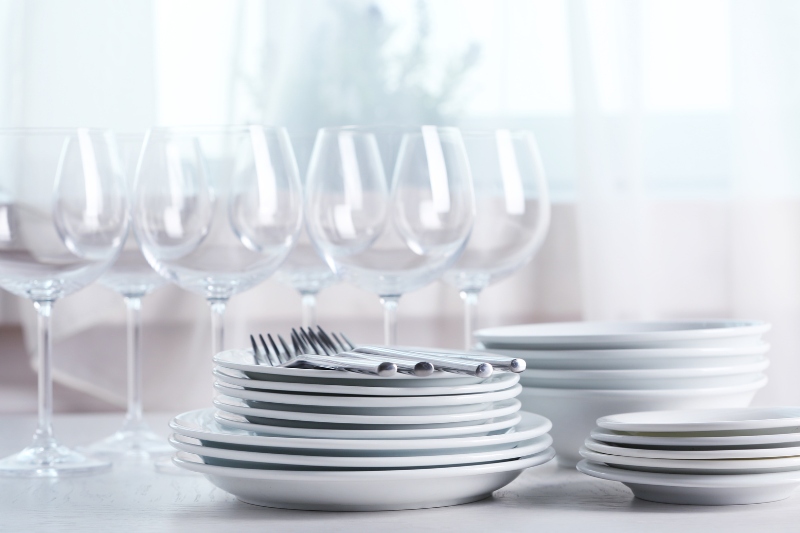Dish drying racks can be cumbersome, unattractive, and gunk-ridden.
So, why not go without one? You can save space in your kitchen, and you won’t have to look at something unsightly.
Sounds like a win-win situation!
There is, however, one small issue with this, and that is, how do you dry dishes without a dish rack? After all, the wet crockery has to go somewhere. So, where can you put them to dry?
There are many different ways you can dry wet cookware, and you can learn how to dry dishes without using a traditional drying rack below.
Below you’ll find several alternative ways of air-drying wet dishes. Pick your favourite one (or two!) and give it (them) a go!
1. Dish Drying Mat

Dish drying mats are a great space-saving option for those of you who don’t have room to house a traditional dish drainer.
A drying mat looks a lot like a small mat, and it’s placed on top of a worktop, and you pop dishes on it.
Dish drying mats are super easy to use, are non-slip and can be stored away when not in use.
They usually come in microfibre or silicon materials, can absorb huge amounts of water and are generally kind on dishes (don’t chip them, for example).
They must, however, be cleaned on a regular basis, otherwise, the wet material will become a haven for bacteria! Yucky!
As it happens, drying mats made from microfibre can be washed in a washing machine, so you can wash them often and with very little effort.
This Brabantia Microfibre Dish Drying Mat is one of my favourites as it can hold a staggering amount of water (seven times its own weight).
The colour is aesthetically pleasing and doesn’t look out of place in a kitchen. Its compact size also means that it doesn’t encroach on your worktop space.
2. Roll-Up Dish Drying Rack
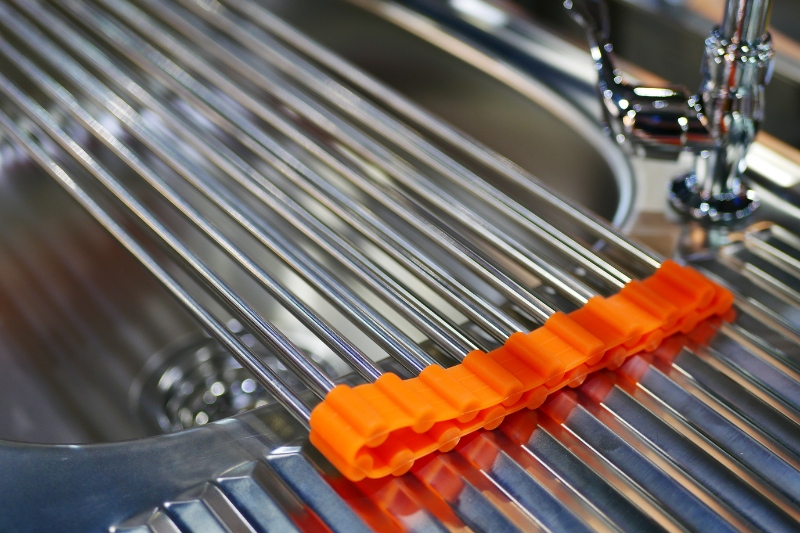
If you don’t have much worktop space, you could dry your dishes over the sink instead.
This idea is very similar to the dish drying mat suggestion mentioned above, the only significant difference is that you roll this particular drying mat over a sink instead of over a worktop.
You then pop your dishes on top of the bars so they can dry. It’s a very straightforward process.
The only drawback with this idea is… Where do you store your clean dishes when you’re still washing crockery in the sink?
In this case, you’d probably have to cover a surface in paper towels and put the dishes on the towels while you carried on washing the dishes in the sink.
Then you’d have to move the crockery back to the sink once you’d covered it with the sink mat. So, there may be a lot of carrying dishes back and forth involved!
You could, on the other hand, cover half your sink with the rolling dish rack and continue to clean your dishes in the sink, but you’d have to be careful and need a large sink!
The Over The Sink Rolling Drainer at Dunelm is a stainless steel drying rack that doubles as a heat mat when it’s not holding wet dishes.
It’s a super handy tool to have at home if you’ve not got much workspace in your kitchen.
It can also be stored away when not in use, but it might come in handy for holding hot pots and pans!
3. Draining Board
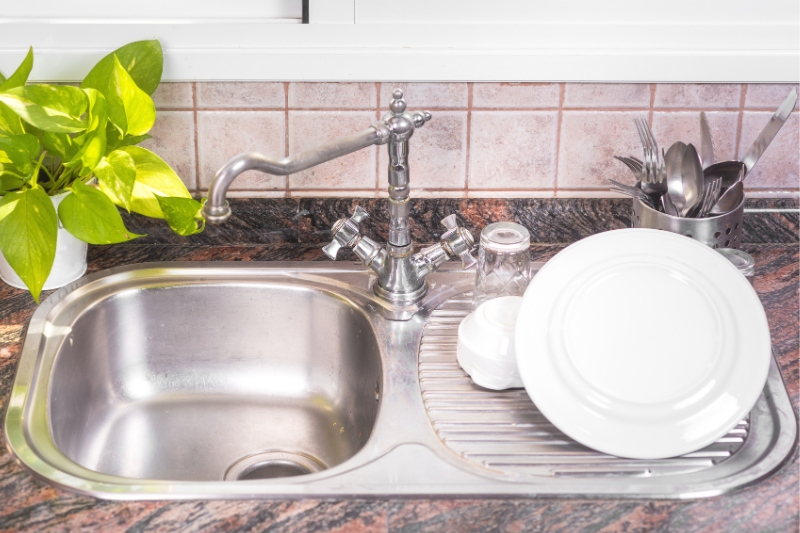
Most sinks come with a sink section and a flat surface to one side that is known by many as a draining board.
The draining board is typically where you’d put a dish drying rack, but if you don’t like using a rack, why not just use the draining board to dry your cookware?
All you’d need to do is make sure the draining board is clean and start placing your dishes carefully onto it. The board itself might not be anti-slip, so you’d have to be careful when it comes to piling up your dishes.
It should, however. be able to hold a level load of crockery with ease.
4. Wall-Mounted Drying Rack
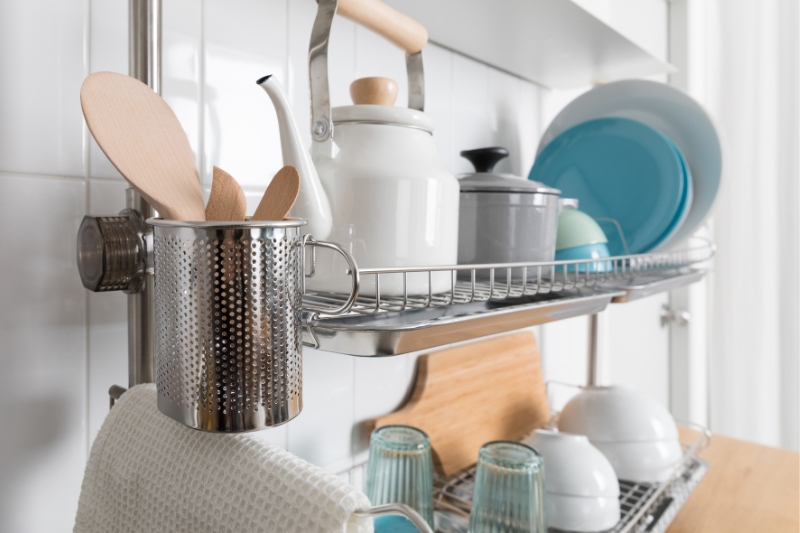
If you can’t use a conventional drying rack that is usually placed on a draining board/worktop, you could get one that goes on a wall.
Wall-mounted drying racks work in the same way as traditional drying racks, the only significant difference is that the rack is stuck onto a wall.
Wall-mounted drying racks come with individual slots that can hold your plates, utensils and cups, and there’s usually a drip tray underneath each layer in the rack to catch the water that comes off the dishes.
One example of this kind of drying rack is the ZJF WDK Wall-Mounted Stainless Steel Dish Rack. This mounted rack is made from stainless steel, can be used to hold a plethora of dishes, and doubles up as a storage space.
It’s the ideal drying rack to have at home if you don’t have much/any worktop space available.
5. Tea Towels
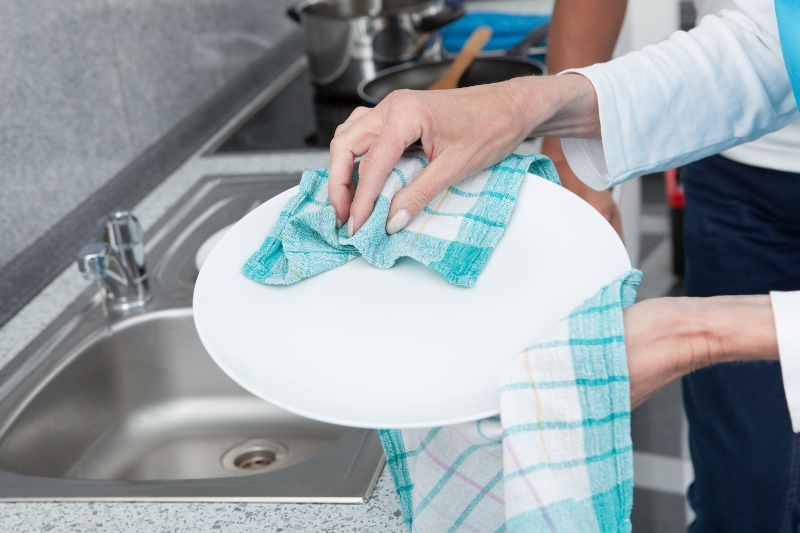
An old-school way to dry dishes is to dry them by hand using a tea towel.
When using a tea towel to dry crockery, you need to use a towel that’s made from a soft material, so you don’t scratch or damage your cookware. And you must make sure that the tea towel you use has only been used to wipe dishes.
You shouldn’t use the same tea towel to dry your hands, face, and crockery, as this is how germs are spread around.
6. Kitchen Roll
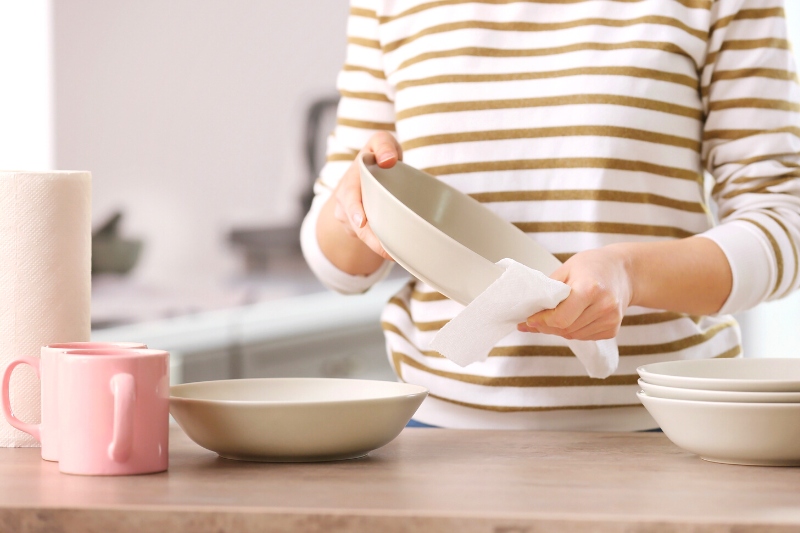
The kitchen roll idea works in a similar way to the tea towel suggestion above, in the sense that you physically have to wipe the crockery dry.
The only significant difference is that kitchen roll is a single-use kind of product. So, essentially once you’ve wiped a dish or two and the paper towel is wet, you have to bin it and rip off another piece of kitchen roll, so you can continue drying your crockery.
To some extent, continuously using a new piece of paper to wipe your dishes is more hygienic. It is not, however, the most cost-effective or environmentally friendly approach to take.
You could go through loads of kitchen rolls per week if you dried all your dishes every day in this way! It certainly wouldn’t be practical to do this in the long term.
7. Hang Pots and Pans Up
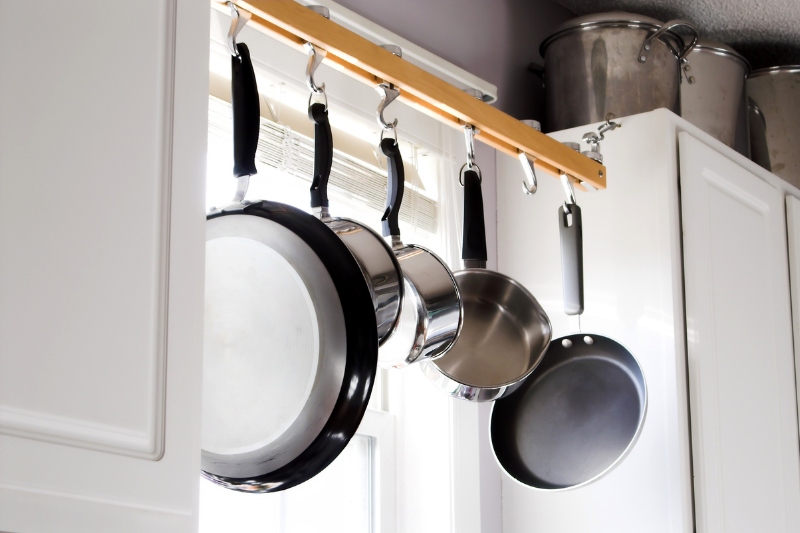
If you can hang your pots and pans up above your sink after you’ve washed them, do so.
Just give your pans a good shake to remove as much water as possible, and then hook them up. Your cooking equipment will air-dry in no time if you do this!
8. Use Your Dishwasher’s Racks as Drying Racks
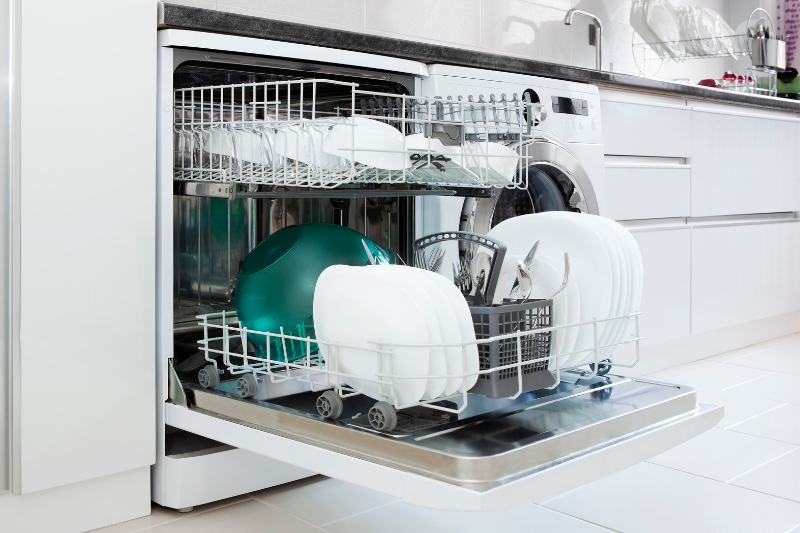
If you’ve got a dishwasher at home but have washed something up in the sink, you can use it as a drying rack.
All you need to do is make sure the dishwasher’s racks are clean, load your dishes onto them, leave the dishwasher’s door open, and then wait for the items to air-dry.
9. Dishwasher Drying Feature
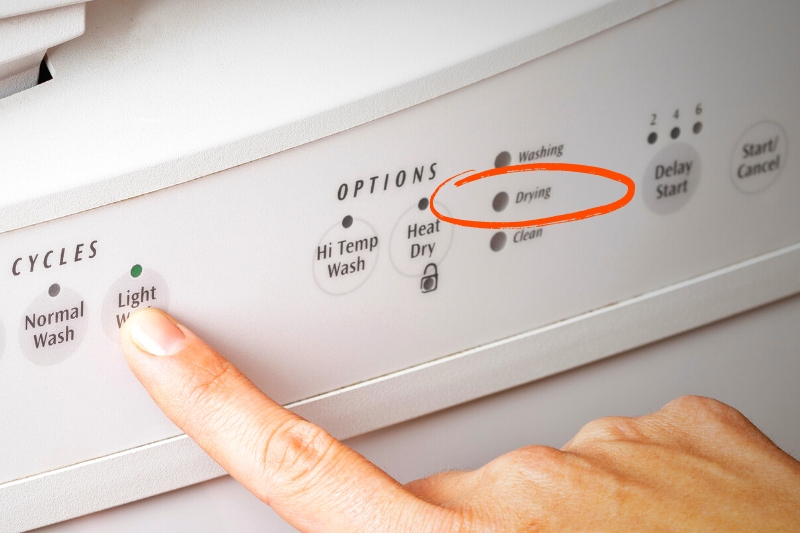
Some dishwashers, but not all, come with a feature that helps to dry crockery for you.
If your dishwasher has this, you should make use of it. The drying process will become part of the bigger washing process, and the cycle won’t take much longer to complete.
In the end, you’ll not only have clean dishes but dry ones too! This’ll save you a lot of time in the long run.
10. Cupboard Organiser
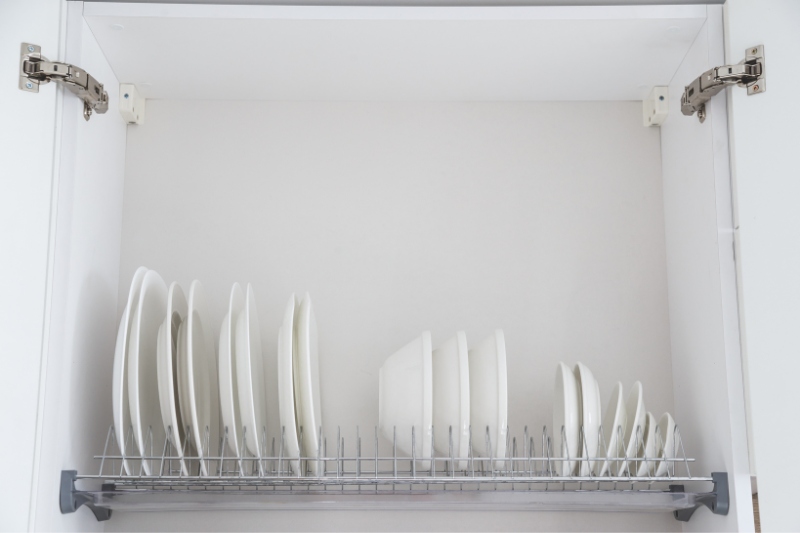
As a backup option, you could buy yourself a cupboard organiser and store your wet dishes on this.
For this method to work out for the best, you need to cover a surface with some kitchen roll/tea towel and place the organiser on top of it.
You can then load a few dishes at a time onto the rack and wait for them to air-dry.
11. Grill Rack
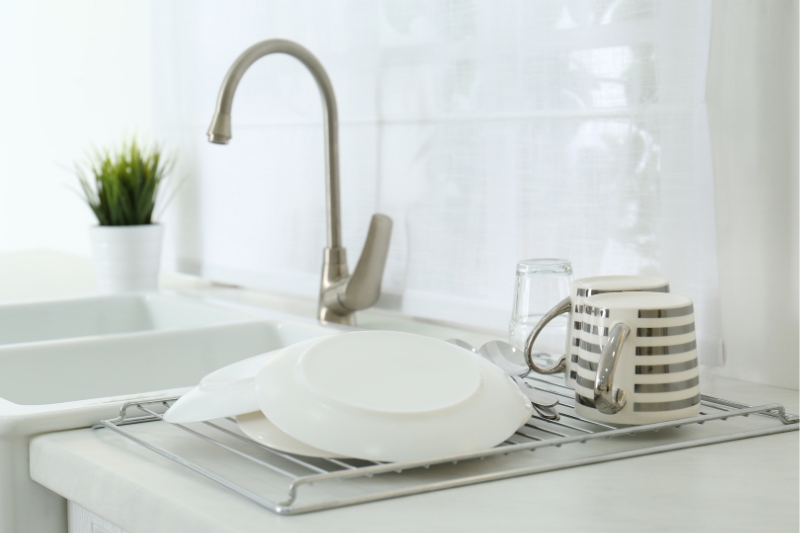
Not got time to pop out to buy fancy drying equipment? No problem, just make use of what you’ve already got at home!
If you have a grill at home, you’ll notice that the grill pan comes with a rack.
This rack is used to hold food when cooking (where you’d place your toast/bacon), and can also double as a mini drying rack.
If you can remove this rack, which you can do in most cases, you can pop it on a tea towel and put clean dishes on it.
You won’t be able to put a huge amount of crockery onto the grill’s rack, but it’s a handy backup option for you to try out.
12. Non-Slip Tray
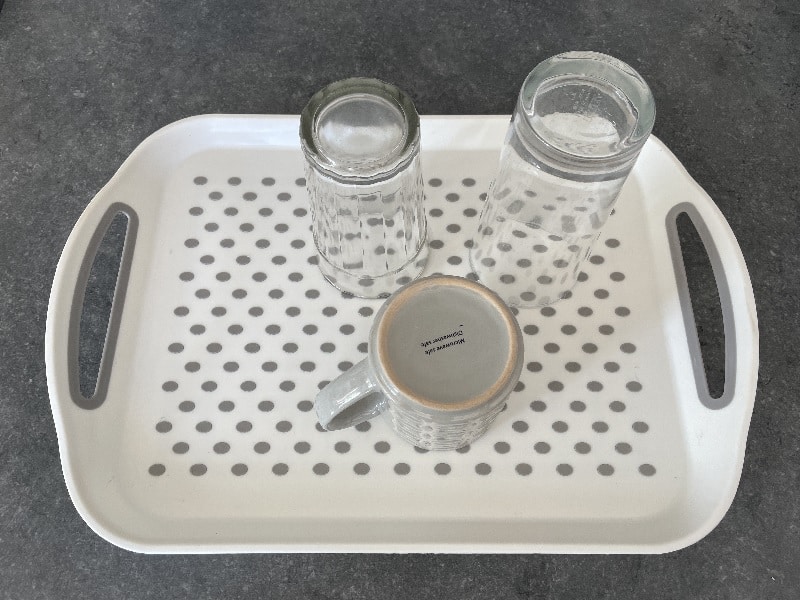
Not got room to dry your dishes in the kitchen? Why not get a non-slip tray, pop the wet crockery on there to dry, and then move the tray to another room in your property so it’s out of the way?
A non-slip tray can hold a few wet dishes at a time, can be put on a number of flat surfaces, is usually deep enough so it can hold water, and comes with handles so you can carry it around.
It’s the ideal drying solution to try out if you need to move your wet dishes from one room to another, but you don’t want water sloshing everywhere as you walk around!
The non-slip surface also stops crockery from sliding about the place as an added bonus.
You won’t be able to fit a huge number of dishes on the surface, but it’s a great backup option!
13. DIY Dish Rack Using Clothes Hangers

If you’ve got a few spare clothes hangers lying about the place, you could try shaping them into a DIY dish rack.
There are a few tutorials for doing this online, including this Instructables tutorial that uses wooden clothes hangers.
This is a cost-effective method that you can try out, and it’s also a fun, creative project for you to work on.
FAQs on Drying Dishes

How do you dry dishes without counter space?
If you don’t have counter space in your home, try using a wall-mounted drying rack, a non-slip tray, or hang your cookware up above the sink to dry them.
Can you use a towel to dry dishes?
Yes, you can use a tea towel to dry dishes. However, you must ensure that the tea towel in question is only used to dry dishes and is washed frequently. You shouldn’t use the same tea towel to wipe hands, faces, floors and dishes, as this is unhygienic!
Is it okay to put dishes away when they are wet?
No, you shouldn’t put dishes away when they are still wet. Dishes need to be dry before they are stored.
If crockery is still wet when it is put away, the moisture can encourage mould to grow in the cupboard.
In some extreme cases, too much moisture in a cabinet can damage and weaken the cupboard itself.

Bethan has a passion for exploring, reading, cooking and gardening! When she’s not creating culinary delights for her family, she’s concocting potions to keep her house clean!
